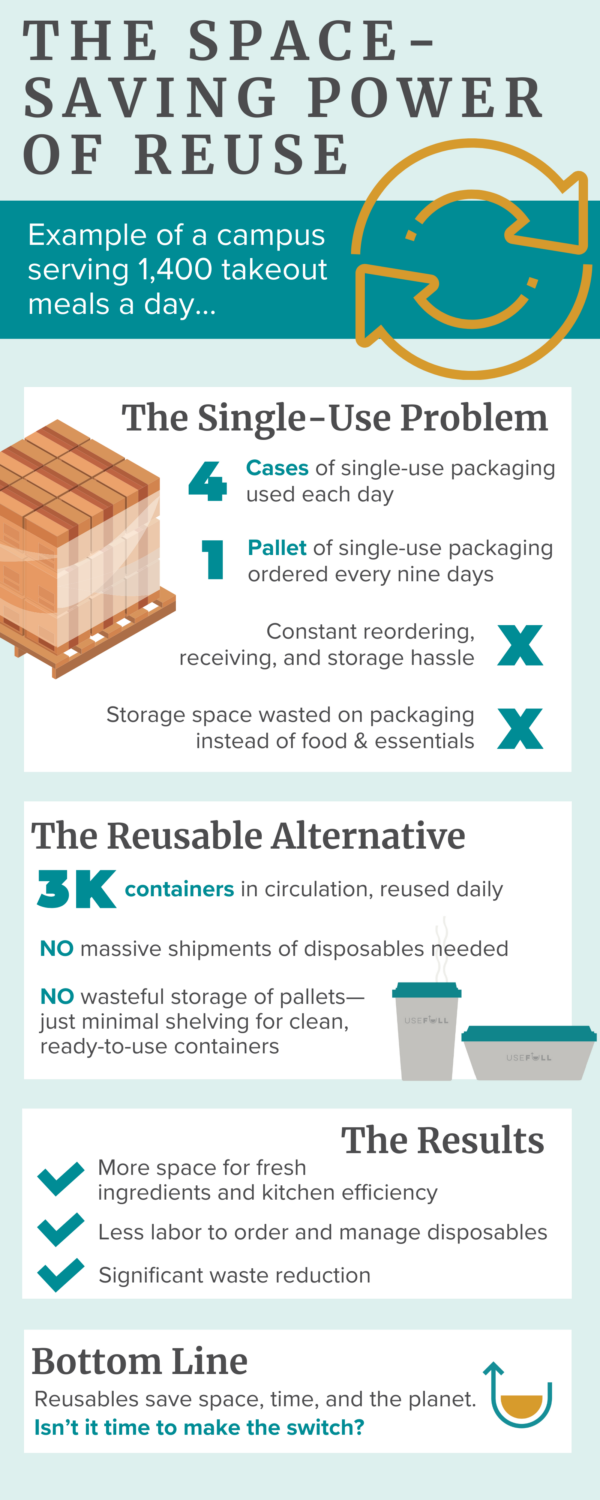When you think about reusable containers, you may think about saving the planet – but did you know that you could be saving space as well? Storage space, that is! (Sorry, we can never resist a pun).
So many foodservice operations struggle with storage space – especially at urban college campuses. Storage is often at a premium in the back of the house, with shipments of food, beverages, and paper goods moving in and out all day long. Add to that to cleaning supplies, pots and pans, and cases of single-use takeout containers and you have quite a crowd!
That’s where reusable containers come to the rescue. Our campus partners are frequently surprised to learn how much space savings can come with a reusable program. How is that possible, you ask? Well, for starters, the life of a reusable container is very different from a single use container.
Single use containers are purchased in bulk, and if you are like many campuses, you go through hundreds (if not thousands) of containers each month – a number that continues to increase as on-the-go takeout culture grows. Let’s use this urban campus example.
Currently, they have about 1,400 to-go meals served each day. Since they are attempting to be sustainable, they purchase biodegradable clamshells. More than a thousand to go meals a day means that they use about four cases of clamshells each day – OR an entire pallet of containers every nine days. A whole pallet! That takes up a lot of space. Not only that, the containers must be constantly reordered, received, and stored. That’s a lot of extra work.
Now, let’s consider the lifecycle of a reusable container in the situation outlined above. If you have 1,400 to go meals served each day – and allow students to keep the containers for two days before returning them – that means you should have about 3,000 containers on hand to meet to-go demand.
On Day 1, 1,400 containers are put into circulation, leaving 1,600 behind. Day 2, based on our data, about 700 containers will be returned and sent back to the dish room. Also, on Day 2, another 1,400 containers will be deployed. By Day 3, all of the initial containers have been returned and washed, and the cycle continues. At any given moment, a reusable container is either:
- Clean and ready
- In use
- In a return bin
- In the dish room
And then the cycle continues!

At USEFULL, we have been collecting and analyzing data for years. We know that the average USEFULL container is returned in 27 hours – regardless of how long the allotted usage period is. So, you can feel safe knowing that if you implement our reusable program, you never have to worry about overcrowding in your storage room or worse, running out of disposable take out containers entirely. Isn’t it time to save the earth….and space?
Get in touch today to chat all things reuse.





